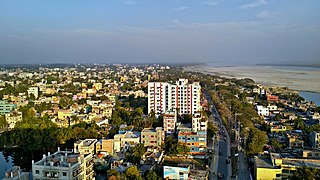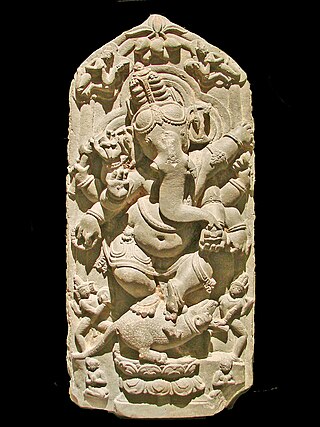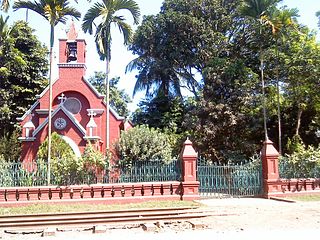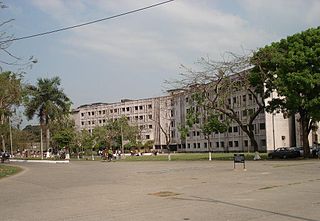External links
24°48′N88°42′E / 24.8°N 88.7°E
Barind Tract (alternately called the Varendra Tract in English and Borendro Bhumi in Bengali) is the largest Pleistocene era physiographic unit in the Bengal Basin. It covers most of Dinajpur, Rangpur, Pabna, Rajshahi, Bogra, and Joypurhat districts of Rajshahi Division and Rangpur Division in Bangladesh. It is made up of several separate sections in the northwestern part of Bangladesh covering a total area of approximately 10,000 square kilometres (3,900 sq mi) of mostly old alluvium. On the eastern edge of the tract is a lower fault escarpment. Through the fault troughs run the little Jamuna, Atrai and Lower Punarbhaba rivers. To the west, the main area is tilted up, and to the east this area is tilted downwards. [1] The climate of the tract differs from that of much of India, in that more extreme temperature variations (ranging from 45 degrees Celsius down to five degrees Celsius) are encountered there. It is divided into three units: The Recent Alluvial Fan, the Barind Pleistocene, and the Recent Floodplain. These are divided by long, narrow bands of recent alluvium. [2]
24°48′N88°42′E / 24.8°N 88.7°E

Rajshahi Division is one of the eight first-level administrative divisions of Bangladesh. It has an area of 18,174.4 square kilometres (7,017.2 sq mi) and a population at the 2022 Census of 20,353,119. Rajshahi Division consists of 8 districts, 70 Upazilas and 1,092 Unions.

Rajshahi is a metropolitan city and a major urban, commercial and educational centre of Bangladesh. It is also the administrative seat of the eponymous division and district. Located on the north bank of the Padma River, near the Bangladesh-India border, the city is surrounded by the satellite towns of Nowhata and Katakhali, which together build an urban agglomeration of about 1 million population. Modern Rajshahi lies in the ancient region of Pundravardhana. The foundation of the city dates to 1634, according to epigraphic records at the mausoleum of Sufi saint Shah Makhdum. The area hosted a Dutch settlement in the 18th century. The Rajshahi municipality was constituted during the British Raj in 1876. It was a divisional capital of the greater Rajshahi division which was the largest division in Bengal Province.

Kurigram District is a district of Bangladesh in the Rangpur Division. The district is located in northern Bangladesh along the country's border with India. Under Indian rule, the area was organized as a mahakuma and was not established as a district until 1984.

Rangpur is one of the major cities in Bangladesh and Rangpur Division. Rangpur was declared a district headquarters on December 16, 1769, and established as a municipality in 1869, making it one of the oldest municipalities in Bangladesh. The municipal office building was erected in 1892 under the precedence Raja Janaki Ballav, Senior Chairman of the municipality. In 1890, the Shyamasundari canal was excavated for the improvement of the town. Sharfuddin Ahmed Jhantu was first mayor of Rangpur City Corporation. Now Rangpur City Corporation is the 2nd largest city corporation in Bangladesh. it's about 205 square kilometres. Rangpur is famous for Shataranji, Haribhanga (mango), Rangpur (fruit) and tobacco. Rangpur is called Baher Desh.

Chapainawabganj is located in the north-western part of Bangladesh. It is a part of the Rajshahi Division, and was formerly a sub-division of Malda district. The north and west part of Chapai Nawabganj is bounded by Malda and Murshidabad districts of India, the east by Naogaon District, and south-east by Rajshahi District.

North Bengal is a term used for the north-western part of Bangladesh and northern part of West Bengal. The Bangladesh part denotes the Rajshahi Division and Rangpur Division. Generally, it is the area lying west of Jamuna River and north of Padma River and includes the Barind Tract. The West Bengal part denotes Jalpaiguri Division and the Malda division together. The Bihar parts include the Kishanganj district. It also includes parts of Darjeeling Hills. Traditionally, the Ganga River divides Bengal into South Bengal and North Bengal, divided again into Terai and Dooars regions. Jalpesh and jatileswar are some of the most popular sacred places.

Bangladesh is divided into 8 divisions (bibhag) and 64 districts, although these have only a limited role in public policy. For the purposes of local government, the country is divided into upazilas (sub-districts), "municipalities" or town councils (pourashova), city corporations and union councils . The diagram below outlines the five tiers of government in Bangladesh.

Saidpur is a city of Nilphamari district in Rangpur Division of Bangladesh. The city has become a very important communication hub for adjoining major district headquarters. Saidpur Airport is one of the domestic airports in Bangladesh. The Syedpur Railway Workshop, established in 1870, is the largest in Bangladesh and was the major railway workshop for Assam-Bengal railway. The city has historically been an Urdu-speaking community with close ties to Bihar.

Rangpur Medical College (RpMC) is a public medical college located in Rangpur, Bangladesh. The college is founded in 1972 and affiliated with Rajshahi Medical University.

Eastern Bengal and Assam was an administrative subdivision (province) of British India between 1905 and 1912. Headquartered in the city of Dacca, it covered territories in what are now Bangladesh, Northeast India and Northern West Bengal.

The National Cricket League is the oldest domestic first-class cricket competition in Bangladesh. It is contested by teams representing seven of the eight regional divisions of Bangladesh as well as a team from the Dhaka metropolitan area.
Puthia is an Upazila of Rajshahi District in the Division of Rajshahi, Bangladesh.

The national language and official language of Bangladesh is Bangla according to the third article of the Constitution of Bangladesh. The second most spoken language in Bangladesh is claimed to be Burmese which is spoken by the Marma tribe in Chittagong Hill districts as the districts border Myanmar; it is also spoken by the Rohingya people. Almost 99% of Bangladeshis speak Bengali as their first language. Bengali Language Implementation Act, 1987 made it mandatory to use Bengali in all government affairs except in the cases of foreign relations. According to a 2022 census, Bengali is predominantly spoken by 99% of the country's population and it also serves as the national language of the nation. The indigenous people of northern and southeastern Bangladesh speak a variety of native languages. Bangladesh has 44 indigenous languages according to Professor Shameem Reza.

Madhupur tract is a large upland area of 4,244 km2 in north central part of Bangladesh, stretching from east of Jamalpur in the north, to Fatullah and Narayanganj, in the south. The tract is mostly one large tract, unlike the Barind Tract. It is approximately one to ten metres above the nearby floodplains.

The Geology of Bangladesh is affected by the country's location, as Bangladesh is mainly a riverine country. It is the eastern two-thirds of the Ganges and Brahmaputra river delta plain stretching to the north from the Bay of Bengal. There are two small areas of slightly higher land in the north-centre and north-west composed of old alluvium called the Madhupur Tract and the Barind Tract, and steep, folded, hill ranges of older (Tertiary) rocks along the eastern border.

Varendra, also known as Barind, was a region of North Bengal, now mostly in Bangladesh and a little portion in the Indian state of West Bengal.

Rajshahi Krishi Unnayan Bank is a state-owned specialized bank in Bangladesh, a specialized financial institution for financing the farmers of the 16 districts of Rajshahi and Rangpur. The headquarters of the bank is in Rajshahi.

Rangpur Division is one of the Divisions in Bangladesh. It was formed on 25 January 2010, as Bangladesh's 7th division. Before that, it was under Rajshahi Division. The Rangpur division consists of eight districts. There are 58 Upazilas or subdistricts under these eight districts. Rangpur is the northernmost division of Bangladesh and has a population of 17,610,956 in the 2022 Census.

The divisions of Bangladesh are divided into 64 districts or zila. The headquarters of a district is called a district seat. The districts are further subdivided into 495 subdistricts or upazilas.